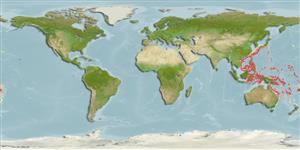Environment: milieu / climate zone / depth range / distribution range
Ökologie
seewasser bathydemersal; tiefenbereich 180 - 410 m (Ref. 11015). Deep-water
Western Pacific: Japan to Western Australia.
Size / Gewicht / Alter
Maturity: Lm ? range ? - ? cm
Max length : 13.0 cm SL Männchen/unbestimmt; (Ref. 11015)
Rückenflossenstacheln (insgesamt): 27; Rückenflossenweichstrahlen (insgesamt): 9-10; Afterflossenstacheln 2; Afterflossenweichstrahlen: 6. Color in life pink, with 5 indefinite large dark blotches on the sides of the body: the first three below the spinous dorsal, one below the soft dorsal and one on the base of the caudal fin.
Found on the continental shelf (Ref. 11015) and continental slope. Benthic (Ref. 75154).
Life cycle and mating behavior
Geschlechtsreife | Fortpflanzung | Ablaichen | Eier | Fecundity | Larven
Eschmeyer, W.N. and B.B. Collette, 1966. The scorpionfish subfamily Setarchinae, including the genus Ectreposebastes. Bull. Mar. Sci. 16(2):349-375. (Ref. 11015)
IUCN Rote Liste Status (Ref. 130435)
Bedrohung für Menschen
Venomous
Nutzung durch Menschen
Fischereien: nicht kommerziell
Mehr Information
NamenSynonymeMetabolismusRäuberÖkotoxikologieFortpflanzungGeschlechtsreifeAblaichenSpawning aggregationFecundityEierEientwicklung
ReferenzenAquakulturAquakultur ProfilZuchtlinienGenetikElectrophoresesVererbbarkeitKrankheitenVerarbeitungNutrientsMass conversion
PartnerBilderStamps, Coins Misc.LauteCiguateraGeschwindigkeitSchwimmstilKiemenoberflächeOtolithsGehirngrößeSehfähigkeit
Tools
Zusatzinformationen
Download XML
Internet Quellen
Estimates based on models
Preferred temperature (Ref.
123201): 11.3 - 19.8, mean 14.4 °C (based on 78 cells).
Phylogenetic diversity index (Ref.
82804): PD
50 = 0.7578 [Uniqueness, from 0.5 = low to 2.0 = high].
Bayesian length-weight: a=0.01047 (0.00417 - 0.02629), b=3.04 (2.82 - 3.26), in cm total length, based on LWR estimates for this (Sub)family-body shape (Ref.
93245).
Trophic level (Ref.
69278): 3.2 ±0.4 se; based on size and trophs of closest relatives
Fishing Vulnerability (Ref.
59153): Low vulnerability (10 of 100).
